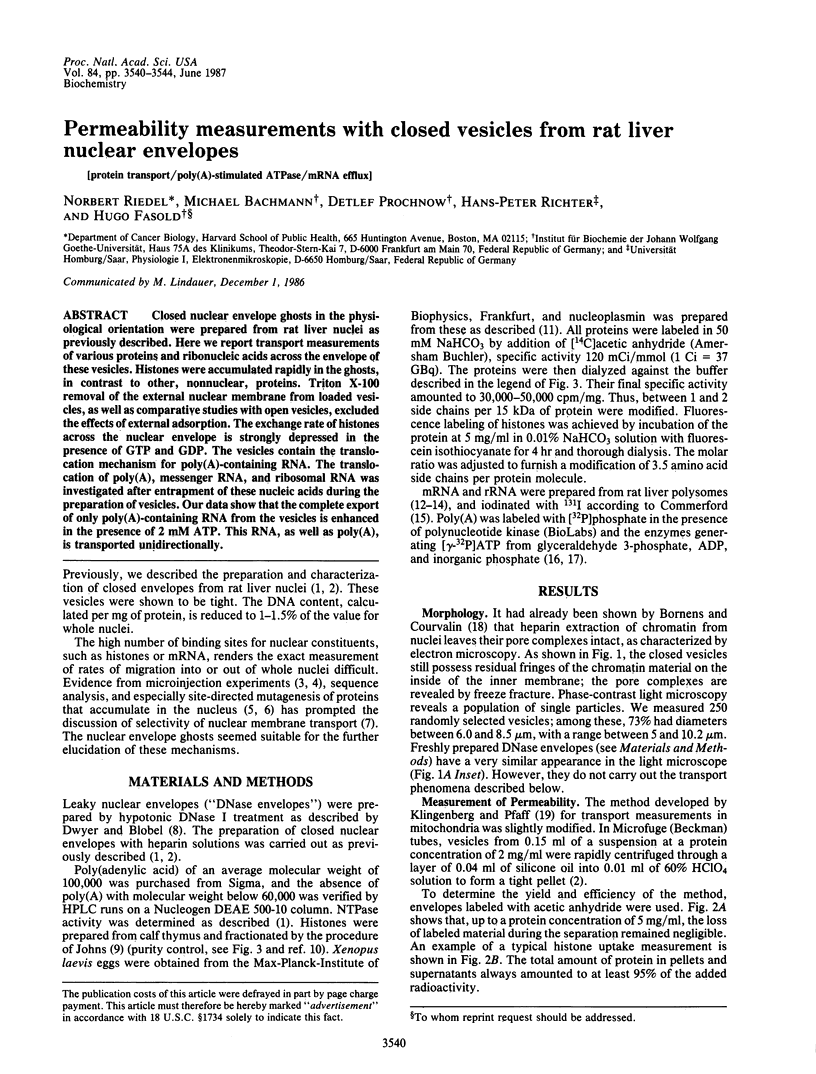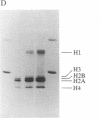Abstract
Closed nuclear envelope ghosts in the physiological orientation were prepared from rat liver and nuclei as previously described. Here we report transport measurements of various proteins and ribonucleic acids across the envelope of these vesicles. Histones were accumulated rapidly in the ghosts, in contrast to other, nonnuclear, proteins. Triton X-100 removal of the external nuclear membrane from loaded vesicles, as well as comparative studies with open vesicles, excluded the effects of external adsorption. The exchange rate of histones across the nuclear envelope is strongly depressed in the presence of GTP and GDP. The vesicles contain the translocation mechanism for poly(A)-containing RNA. The translocation of poly(A), messenger RNA, and ribosomal RNA was investigated after entrapment of these nucleic acids during the preparation of vesicles. Our data show that the complete export of only poly(A)-containing RNA from the vesicles is enhanced in the presence of 2 mM ATP. This RNA, as well as poly(A), is transported unidirectionally.
Full text
PDF




Images in this article
Selected References
These references are in PubMed. This may not be the complete list of references from this article.
- Aaronson R. P., Blobel G. On the attachment of the nuclear pore complex. J Cell Biol. 1974 Sep;62(3):746–754. doi: 10.1083/jcb.62.3.746. [DOI] [PMC free article] [PubMed] [Google Scholar]
- Agutter P. S. Influence of nucleotides, cations and nucleoside triphosphatase inhibitors on the release of ribonucleic acid from isolated rat liver nuclei. Biochem J. 1980 Apr 15;188(1):91–97. doi: 10.1042/bj1880091. [DOI] [PMC free article] [PubMed] [Google Scholar]
- Bornens M., Courvalin J. C. Isolation of nuclear envelopes with polyanions. J Cell Biol. 1978 Jan;76(1):191–206. doi: 10.1083/jcb.76.1.191. [DOI] [PMC free article] [PubMed] [Google Scholar]
- Commerford S. L. Iodination of nucleic acids in vitro. Biochemistry. 1971 May 25;10(11):1993–2000. doi: 10.1021/bi00787a005. [DOI] [PubMed] [Google Scholar]
- Cox G. S. Discrimination in the uptake of soluble proteins by isolated nuclei. J Cell Sci. 1982 Dec;58:363–384. doi: 10.1242/jcs.58.1.363. [DOI] [PubMed] [Google Scholar]
- Dabauvalle M. C., Franke W. W. Karyophilic proteins: polypeptides synthesized in vitro accumulate in the nucleus on microinjection into the cytoplasm of amphibian oocytes. Proc Natl Acad Sci U S A. 1982 Sep;79(17):5302–5306. doi: 10.1073/pnas.79.17.5302. [DOI] [PMC free article] [PubMed] [Google Scholar]
- Davey J., Dimmock N. J., Colman A. Identification of the sequence responsible for the nuclear accumulation of the influenza virus nucleoprotein in Xenopus oocytes. Cell. 1985 Mar;40(3):667–675. doi: 10.1016/0092-8674(85)90215-6. [DOI] [PubMed] [Google Scholar]
- Dwyer N., Blobel G. A modified procedure for the isolation of a pore complex-lamina fraction from rat liver nuclei. J Cell Biol. 1976 Sep;70(3):581–591. doi: 10.1083/jcb.70.3.581. [DOI] [PMC free article] [PubMed] [Google Scholar]
- Feldherr C. M., Cohen R. J., Ogburn J. A. Evidence for mediated protein uptake by amphibian oocyte nuclei. J Cell Biol. 1983 May;96(5):1486–1490. doi: 10.1083/jcb.96.5.1486. [DOI] [PMC free article] [PubMed] [Google Scholar]
- Glynn I. M., Chappell J. B. A simple method for the preparation of 32-P-labelled adenosine triphosphate of high specific activity. Biochem J. 1964 Jan;90(1):147–149. doi: 10.1042/bj0900147. [DOI] [PMC free article] [PubMed] [Google Scholar]
- Johns E. W. Studies on histones. 7. Preparative methods for histone fractions from calf thymus. Biochem J. 1964 Jul;92(1):55–59. doi: 10.1042/bj0920055. [DOI] [PMC free article] [PubMed] [Google Scholar]
- Kaempfer R. Binding of messenger RNA in initiation of eukaryotic translation. Methods Enzymol. 1979;60:380–392. doi: 10.1016/s0076-6879(79)60036-8. [DOI] [PubMed] [Google Scholar]
- Kalderon D., Roberts B. L., Richardson W. D., Smith A. E. A short amino acid sequence able to specify nuclear location. Cell. 1984 Dec;39(3 Pt 2):499–509. doi: 10.1016/0092-8674(84)90457-4. [DOI] [PubMed] [Google Scholar]
- Kleinschmidt J. A., Fortkamp E., Krohne G., Zentgraf H., Franke W. W. Co-existence of two different types of soluble histone complexes in nuclei of Xenopus laevis oocytes. J Biol Chem. 1985 Jan 25;260(2):1166–1176. [PubMed] [Google Scholar]
- Kondor-Koch C., Riedel N., Valentin R., Fasold H., Fischer H. Characterization of an ATPase on the inside of rat-liver nuclear envelopes by affinity labeling. Eur J Biochem. 1982 Oct;127(2):285–289. doi: 10.1111/j.1432-1033.1982.tb06868.x. [DOI] [PubMed] [Google Scholar]
- Krystosek A., Cawthon M. L., Kabat D. Improved methods for purification and assay of eukaryotic messenger ribonucleic acids and ribosomes. Quantitative analysis of their interaction in a fractionated reticulocyte cell-free system. J Biol Chem. 1975 Aug 10;250(15):6077–6084. [PubMed] [Google Scholar]
- Maul G. G., Avdalović N. Nuclear envelope proteins from Spisula solidissima germinal vesicles. Exp Cell Res. 1980 Nov;130(1):229–240. doi: 10.1016/0014-4827(80)90059-2. [DOI] [PubMed] [Google Scholar]
- Müller W. E. Endoribonuclease IV. A poly(A)-specific ribonuclease from chick oviduct. 1. Purification of the enzyme. Eur J Biochem. 1976 Nov 1;70(1):241–248. doi: 10.1111/j.1432-1033.1976.tb10975.x. [DOI] [PubMed] [Google Scholar]
- Paine P. L., Moore L. C., Horowitz S. B. Nuclear envelope permeability. Nature. 1975 Mar 13;254(5496):109–114. doi: 10.1038/254109a0. [DOI] [PubMed] [Google Scholar]
- Palmiter R. D. Magnesium precipitation of ribonucleoprotein complexes. Expedient techniques for the isolation of undergraded polysomes and messenger ribonucleic acid. Biochemistry. 1974 Aug 13;13(17):3606–3615. doi: 10.1021/bi00714a032. [DOI] [PubMed] [Google Scholar]
- Richardson C. C. Phosphorylation of nucleic acid by an enzyme from T4 bacteriophage-infected Escherichia coli. Proc Natl Acad Sci U S A. 1965 Jul;54(1):158–165. doi: 10.1073/pnas.54.1.158. [DOI] [PMC free article] [PubMed] [Google Scholar]
- Riedel N., Fasold H. Nuclear-envelope vesicles as a model system to study nucleocytoplasmic transport. Specific uptake of nuclear proteins. Biochem J. 1987 Jan 1;241(1):213–219. doi: 10.1042/bj2410213. [DOI] [PMC free article] [PubMed] [Google Scholar]
- Stuart S. E., Clawson G. A., Rottman F. M., Patterson R. J. RNA transport in isolated myeloma nuclei. Transport from membrane-denuded nuclei. J Cell Biol. 1977 Jan;72(1):57–66. doi: 10.1083/jcb.72.1.57. [DOI] [PMC free article] [PubMed] [Google Scholar]












